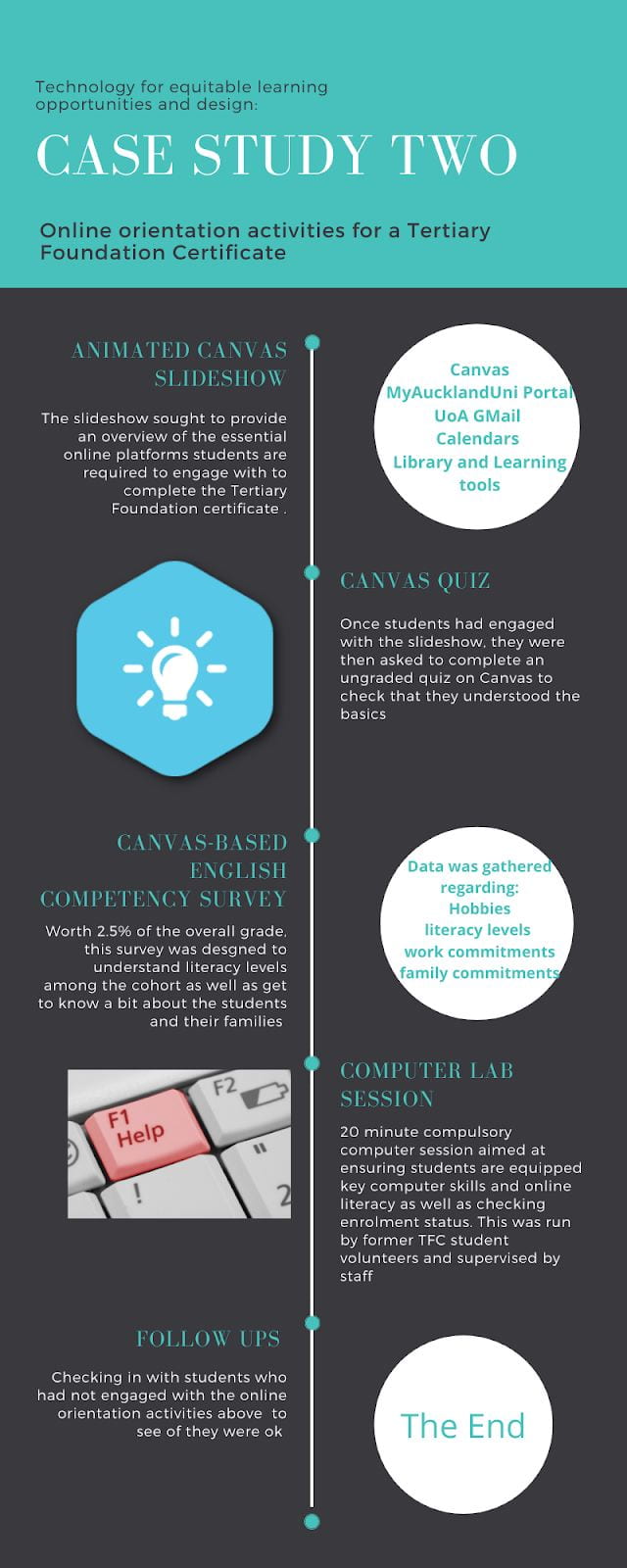Inclusive orientations (Tertiary Foundation Programme)
Dr Agnieszka Zabicka from English in the Faculty of Arts shares her impassioned approach to accessible and inclusive strategies, to welcome students in the Tertiary Foundation Programme (TFP). This case study highlights what can be achieved if you’re committed to equitable, accessible and flexible orientation programmes or just keen on being more inclusive in your approach to technology integration in programmes offered to new students.
Background
The Tertiary Foundation Certificate (TFC) is designed to create a pathway for entry into University. It also seeks to ensure that once students have successfully completed their TFC, they will be equipped with the skills necessary to complete their chosen degree. The TFC programme cohort is often made up of students from a diverse range of educational, cultural and socio-economic backgrounds, often falling within and across intersecting equity groups. In this case, the online orientation project was designed to reflect the diversity among the group and to address the technological challenges that are common for students from equity backgrounds. Technology was used in the design, production and implementation of a series of online orientation activities for students. When asked how the facilitator identified the need for these to be developed, they stated:
Ever since the introduction of Canvas in 2016, I have been aware that the TFC cohort were not altogether conversant with the technology, and they needed a lot of guidance in order to grasp the IT essentials necessary for their academic success. The existing lack of training in online University of Auckland systems for students made it difficult for TFC students to catch up, and this meant that they could miss out on vital information and connections.
The TFC cohort are arguably in more need of online guidance than the general student population on account of their diverse socioeconomic background and life experience. As mentioned above, a sizable percentage of the TFC cohort hails from equity groups; many TFC new entrants have low computer literacy levels and low access to technology. Fostering inclusive learning by addressing this technological gap and making IT essentials accessible to all students was the aim of my Online Orientation plan.
Design: challenges and process
The design, production and implementation of the activities was a coordinated effort with challenges along the way.The Online Orientation activities were made possible through funding support from a Schuler Educational Enhancement and Development (SEED) grant and help from the Centre for Learning and Research in Higher Education (CLeaR) staff. Members of the Canvas support team assisted with the design of online activities, and support was also available to deal with practical issues that arose for students while engaging in the activities. Planning the rollout of the activities (for example, room bookings and the recruitment of student volunteers) on orientation day required the support of the TFC coordinator, which was provided.

The infographic (on the left) shows the activities largely delivered through a compulsory Canvas course called ‘Academic Resilience’, with the exception of the English survey which was embedded in the compulsory TFC English course. Canvas and MyAucklandUni portal were crucial to the success of the pilot. Other learning activities embedded into the orientation experience included:
- Students needing to use their UPI to log in to systems, which meant that staff could have confidence that students knew what their UPI was and their passwords.
- Students becoming well equipped to access relevant material through Canvas, including content (animated slideshow) and quizzes.
- Students learning where to access computer labs on the University campus.
Any students experiencing difficulty were identified very early on in the semester as these activities were delivered during orientation week.
Implementation and evaluation
Gauging online literacy and student capacity to engage with relevant technologies was a clear goal of the programme. Data collection and analysis – to evaluare the approach – was completed by a research assistant.
What worked well?
Overall, online orientation was successful in introducing the TFC students to the basics of online learning. Students benefited from the peer instruction model during the computer lab session with students from the previous year sharing tips and tricks. Though, this was inconsistent as some of the volunteers were more confident than others. This activity also helped identify and assist students with enrolment issues or Canvas access issues early on. This did however present its own issues when students did not have their UPIs or passwords and were therefore unable to log in to the computers. These unforeseen issues did make the session seem chaotic at times. The computer lab session was still positive even with these issues, because in prior years, access issues were frequently unreported until the second week of semester resulting in students being unable to access important learning material and subsequently falling behind in coursework.
What would be done differently?
There is a desire to continue to deliver the Online Orientation activities as part of the TFC programme in the future. Overall, the activities will look similar to the original iteration, however there are some critical learnings which will be taken into account.
- Back-up technical support will be available to iron out access issues as soon as they are identified.
- The activities will be altered to be more dynamic and interactive for the students.
- Early effort will be given to the organisation of groups for the lab session – this includes training for the volunteers so they know what they will be required to do on the day.
This case study overviews activities developed to support students beginning their TFC. These activities could be valuable for all first year students coming into university to ensure that everyone is starting the semester with the same basic online competencies.